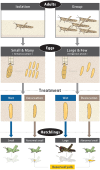Desiccated desert locust embryos reserve yolk as a "lunch box" for posthatching survival
- PMID: 40432906
- PMCID: PMC12107552
- DOI: 10.1093/pnasnexus/pgaf132
Desiccated desert locust embryos reserve yolk as a "lunch box" for posthatching survival
Abstract
Oviparous animals often prioritize the allocation of reproductive resources to egg size over clutch size, but the impact of this maternal investment on the allocation of embryonic yolks and its ecological functions is poorly understood. We investigated how desert locust embryos allocate yolk for survival energy after hatching, rather than embryonic somatic growth depending on egg size in response to desiccation stress. Crowd-reared females (gregarious phase) produced significantly larger progeny with higher tolerance to starvation than females reared in isolation (solitarious phase). Abnormally small hatchlings with residual yolk in their gut emerged from small and large eggs when exposed to desiccation. In particular, these small hatchlings of desiccated eggs survived significantly longer under starvation than those of wet ones, with larger eggs providing even greater survival benefits. Physiological analysis showed that hatchlings from desiccated eggs showed a trade-off by reserving more lipids without somatic growth than those from normal eggs. Desiccation could be a reliable signal for embryos to predict future poor vegetation, and reserved energy could increase the chance of accessing food after hatching. Our results underscore adaptive plasticity in maternal and embryonic resource allocation in desert locusts in response to unpredictably variable semi-arid habitats.
Keywords: adaptive strategy; desiccation; embryos; maternal effects; resource allocation.
© The Author(s) 2025. Published by Oxford University Press on behalf of National Academy of Sciences.
Figures








Similar articles
-
Eggs and hatchlings variations in desert locusts: phase related characteristics and starvation tolerance.Front Physiol. 2013 Dec 4;4:345. doi: 10.3389/fphys.2013.00345. eCollection 2013. Front Physiol. 2013. PMID: 24363645 Free PMC article.
-
Allocation of more reproductive resource to egg size rather than clutch size of gregarious desert locust (Schistocerca gregaria) through increasing oogenesis period and oosorption rate.J Insect Physiol. 2022 Jan;136:104331. doi: 10.1016/j.jinsphys.2021.104331. Epub 2021 Nov 25. J Insect Physiol. 2022. PMID: 34838517
-
The desert locust, Schistocerca gregaria, plastically manipulates egg size by regulating both egg numbers and production rate according to population density.J Insect Physiol. 2020 Apr;122:104020. doi: 10.1016/j.jinsphys.2020.104020. Epub 2020 Feb 6. J Insect Physiol. 2020. PMID: 32035952
-
A review of maternal and embryonic control of phase-dependent progeny characteristics in the desert locust.J Insect Physiol. 2010 Aug;56(8):911-8. doi: 10.1016/j.jinsphys.2010.05.013. Epub 2010 May 28. J Insect Physiol. 2010. PMID: 20493874 Review.
-
Metabolism and energetics of avian embryos.J Exp Zool Suppl. 1987;1:111-25. J Exp Zool Suppl. 1987. PMID: 3298529 Review.
References
-
- Danks HV. 2002. Modification of adverse conditions by insects. Oikos. 99:10–24.
-
- Deeming DC, Ferguson MWJ. Egg incubation: its effects on embryonic development in birds and reptiles. Cambridge University Press, Cambridge, 1991.
-
- Counce SJ. 1961. The analysis of insect embryogenesis. Annu Rev Entomol. 6:295–312.
-
- Kraemer JE, Bennett SH. 1981. Utilization of posthatching yolk in loggerhead sea turtles, Caretta caretta. Copeia. 1981:406–411.
-
- Postlethwait JH, Giorgi F. 1985. Vitellogenesis in insects. In: Browder LW, editor. Developmental biology. A comprehensive synthesis. Vol. 1. New York, London: Plenum Press. p. 85–126. - PubMed
LinkOut - more resources
Full Text Sources

